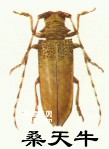Longhorn beetle is also known as brown beetle and iron cannon insect. Distributed in all provinces of my country, and abroad in Japan, North Korea, Vietnam, Myanmar, and India. It is an important pest of many kinds of forest trees and fruit trees in my country. It is the most serious pest to mulberry, fig, pecan, tomentosa poplar, etc., followed by willow, black locust, elm, hackberry, maple poplar, apple, crabapple, sand fruit, pear, pear and so on. , cherries, citrus, etc. After the host is killed, the growth will be poor, the tree will decline prematurely, the utilization value of wood will be reduced, and the yield of mulberry and fruit will be affected.

The adult body length is 34-46 mm. The body and elytra are black, covered with short yellowish-brown hairs, the top of the head is raised, and there is a longitudinal groove in the center. The upper jaw is dark brown, strong and sharp. The antennae have 11 segments, slightly longer than the body, the stalk and stem segments are black, the front half of each subsequent segment is dark brown, and the back half is gray. The front chest is nearly square, with horizontal wrinkles on the back and a spine-like protrusion in the middle of each side. The base of the elytra is densely covered with small, granular black spots. The legs are black and densely covered with short gray hair. The last 2 segments of the female's abdomen are curved downward.
The eggs are oblong, 5-7 mm long, with a thin front end, slightly curved, and yellowish white.
The larvae are cylindrical, 45-60 mm long when grown, cylindrical, and milky white. The head is small, hidden in the chest, and the upper and lower lips are light yellow. The front chest is extremely large, with a hard skin plate on the back, densely covered with yellow-brown bristles, and densely covered with auburn particles on the back half.
The pupa is 50 mm long, spindle-shaped, yellow-brown, with a brown semicircular ring at the end and yellow-brown hairs on it.
Life history and habits: One generation is completed in two or three years, and the larvae overwinter in the trunk. The mature larvae pupate in the insect tunnel of the tree trunk in June and July. The pupal period lasts for 15-20 days and emerge as adults in July and August. After emergence, the adults eat the bark of new branches, young leaves, and buds. Adults lay eggs mostly at night, and the egg-laying sites are mostly on branches with a thickness of 1-2 cm. Before laying eggs, it first bites a "U"-shaped wound on the bark (or a circular wound on a thin branch), then lays one egg in it and seals it with mucus. A female usually lays about 100 eggs. The egg stage is about 15 days. The larvae feed downwards on the branches and make round holes outward at regular intervals for ventilation and discharge of insect excrement (the excrement of the first-instar larvae is reddish-brown and thin rope-like; the excrement of the older larvae is thick and like sawdust). , after about two winters, the larvae will feed underneath the trunk or even to the base. The maximum length of the insect tunnel is about 4 meters.
animal tags:
We created this article in conjunction with AI technology, then made sure it was fact-checked and edited by a Animals Top editor.